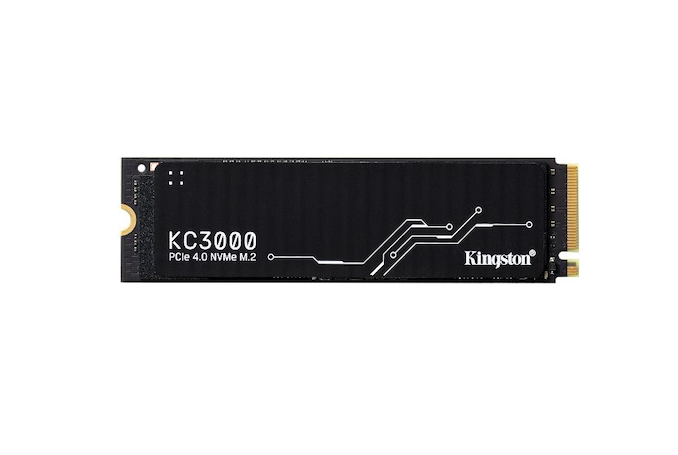Kingston KC3000 PCIe 4.0 NVMe Flagship SSD Hits Retail
by Ganesh T S on October 25, 2021 9:08 AM EST
Kingston had previewed their 2021 flagship PCIe 4.0 x 4 M.2 NVMe SSD (codename "Ghost Tree") at CES earlier this year. Not much was divulged other than the use of the Phison E18 controller at that time. The product is hitting retail shelves today as the KC3000. The M.2 2280 SSD will be available in four capacities ranging from 512GB to 4TB. Kingston also provided us with detailed specifications.
| Kingston KC3000 SSD Specifications | ||||
| Capacity | 512 GB | 1024 GB | 2048 GB | 4096 GB |
| Controller | Phison E18 | |||
| NAND Flash | Micron 176L 3D TLC NAND | |||
| Form-Factor, Interface | Single-Sided M.2-2280, PCIe 4.0 x4, NVMe 1.4 | Double-Sided M.2-2280, PCIe 4.0 x4, NVMe 1.4 | ||
| DRAM | 512 MB DDR4 | 1 GB DDR4 | 2 GB DDR4 | 4 GB DDR4 |
| Sequential Read | 7000 MB/s | |||
| Sequential Write | 3900 MB/s | 6000 MB/s | 7000 MB/s | |
| Random Read IOPS | 450K | 900K | 1M | |
| Random Write IOPS | 900K | 1M | ||
| Avg. Power Consumption | 0.34 W | 0.33 W | 0.36 W | |
| Max. Power Consumption | 2.7 W (R) 4.1 W (W) |
2.8 W (R) 6.3 W (W) |
2.8 W (R) 9.9 W (W) |
2.7 W (R) 10.2 W (W) |
| SLC Caching | Yes | |||
| TCG Opal Encryption | No | |||
| Warranty | 5 years | |||
| Write Endurance | 400 TBW 0.44 DWPD |
800 TBW 0.44 DWPD |
1600 TBW 0.44 DWPD |
3200 TBW 0.44 DWPD |
| MSRP | ? (?¢/GB) | ? (?¢/GB) | ? (?¢/GB) | ? (?¢/GB) |
SSDs based on Phison's E18 controller have been entering the market steadily over the last few months. While early ones like the Sabrent Rocket 4 Plus and Mushkin Gamma Gen 4 came with Micron's 96L flash, the newer ones such as the Corsair MP600 PRO XT and the Kingston's KC3000 are using 176L NAND. The KC3000's 0.44 DWPD endurance rating slightly edges ahead of the MP600 PRO XT's 0.38 DWPD despite similar component choices. Claimed performance numbers are similar to ones achieved by other E18 SSDs with similar NAND configuration - 7GBps for sequential accesses, and up to 1M IOPS for random accesses. The thermal solution involves an overlaid graphene aluminum heat-spreader that still keeps the thickness down to 2.21mm for the single-sided SKUs, and 3.5mm for the double-sided ones. On the power consumption side, the 4TB version can consume as much as 10.2W. On the positive side, all SKUs support a 5mW deep sleep mode.
Kingston is targeting the KC3000 towards both desktops and notebooks. Primary storage-intensive use-cases include 3D rendering and 4K content creation. In this market, the drive is going up against established competition like the Samsung 980 PRO, and Western Digital's SN850. Both of these SSDs have lower endurance numbers and don't have 4TB options, giving the KC3000 an edge for consumers looking at those aspects specifically.










8 Comments
View All Comments
bigmikeman - Monday, October 25, 2021 - link
is a review for the Corsair MP600 PRO XT, or Seagate 530 coming anytime soon?GL1zdA - Tuesday, October 26, 2021 - link
No encryption is the reason I use Samsung drives in all my notebooks, since these do FDE. I don't get it why other manufacturers won't enable it. It saves lots of headaches when your notebook is stolen, or you lose it in another way.bug77 - Tuesday, October 26, 2021 - link
It gives you those headaches back when the drive malfunctions and you try to recover data from it ;)nils_ - Tuesday, October 26, 2021 - link
The usual recommendation is to use the encryption provided by the OS instead since there are vulnerabilities in integrated disk-encryption (as long as it's powered on it stays unlocked).Dug - Wednesday, October 27, 2021 - link
Never lost a notebook. Apparently that is a thing. You should hold onto it like your wallet.But after deploying 100's of laptops using encryption outside the OS, no more. Such a headache and really no recovery.
Samus - Friday, October 29, 2021 - link
SED's using pure hardware encryption are bullshit. Use OS-level encryption with hardware acceleration so you can at least access the data with a recovery key.Things have improved greatly since eDrive (IEEE1667?) and modern Bitlocker is accelerated with Opal2-complaint drives to the point the encryption is virtually transparent from a performance perspective. There is even Bitlocker to Go for external drives which works fantastic. Just print your keys and lock them in a safe.
Oxford Guy - Friday, October 29, 2021 - link
Has Anandtech ever covered all the bait and switch tactics that have been happening recently?Swapping TLC for QLC. Swapping controllers. Downgrading the quality of TLC.
SanX - Saturday, October 30, 2021 - link
Let's do the simplest math estimation. 5 years warranty is 365*5=1825 days. The 0.44DWPD means you can rewrite it 1825*0.44 = 643 times.